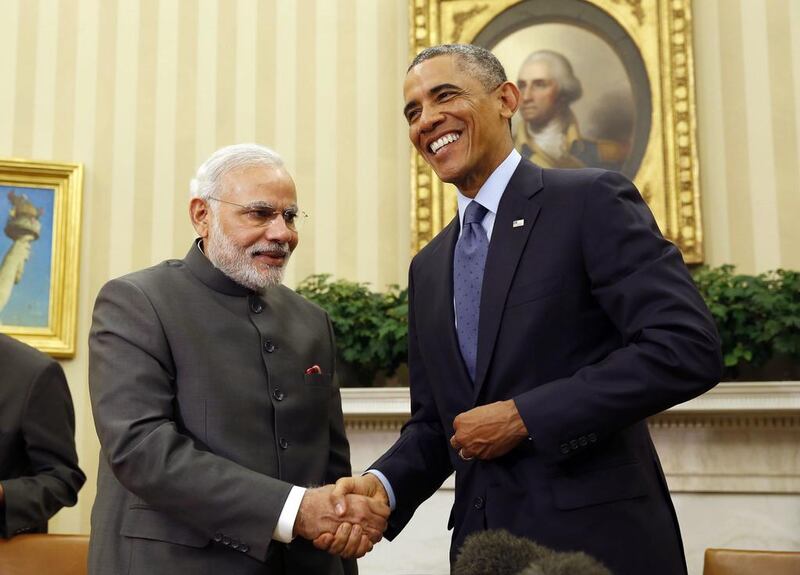MUMBAI // Just a week after Narendra Modi welcomed the Chinese president Xi Jinping in his home state of Gujarat, India’s prime minister jetted off to the United States to charm potential investors and the country’s president, Barack Obama.
The US and China both have economic models which could serve as inspiration for India. On the one hand there are lessons about infrastructure development and manufacturing to be learnt from China, which has outpaced its Asian peer in terms of economic growth. On the other, the innovation and technology found in the US are important points of inspiration.
In the near term, China, as an emerging economy, seems to hold more lessons for India, says Uday Salunkhe, the group director of the Welingkar Institute of Management Development and Research, which has branches in Mumbai and Bangalore.
“India has to develop its own model but it has more to learn from China since it is much closer in its level of development,” he says. “Some of the lessons are invest more in the health and education of your workforce; execute your infrastructure projects in a reasonable time frame and make sure they are financially viable; create manufacturing clusters which will hire lots of workers.”
China has done a much better job in recent years of implementing such strategies, which has left India lagging behind in terms of economic growth, he notes.
Subir Gokarn is the director of research for Brookings Institution India Center in New Delhi and was deputy governor of the Reserve Bank of India between 2009 and 2012. He explains that it is not a matter of choosing one economic model over the other.
“It’s a matter of drawing on elements that have succeeded in both,” says Mr Gokarn. “From the US side, the importance of markets and the contribution that markets have made to economic growth and development, that’s a model we started on in the early ‘90s. From the Chinese, the biggest lesson is how important an efficient state is — particularly our infrastructure has been extremely negative.”
For decades, the Indian economic model has tended to follow a path set by China.
“The ‘50s, ‘60s, ‘70s were very much along the centrally planned and closed economy model that China followed,” Mr Gokarn says. “China went into a dual economy framework in the late ‘70s, keeping the bulk of the economy closed but opening up a part of it, basically integrating it globally. We started to do that to some extent in the ‘80s and really consolidate with that trajectory in the ‘90s. We’ve been following roughly the same path but with somewhat different results — particularly with the role of manufacturing in China’s rapid growth in contrast with the role that services has played in ours.”
India to some extent seems again to be following the Chinese model in terms of the Modi government’s manufacturing ambitions. Last month, Mr Modi unveiled a campaign called “Make in India”, which promises to transform India into a global manufacturing powerhouse.
“India has a reasonable chance of becoming a manufacturing hub with the right policies,” says Mr Salunkhe. “China is moving up in the global value chain, which means higher wages which will steadily create an opening for India. To exploit this India will need better policies on infrastructure, labour laws and vocational training.”
Niranjan Gidwani, the deputy chief executive of Eros Group, a consumer electronics distributor and retailer based in Dubai, says that India has enormous potential in manufacturing and “could serve as a back-end supplier to China, or as an alternative source of supply to the emerging markets and markets in the region”.
India has been widely criticised for the complexity which domestic and foreign companies face when doing business in the country. Mr Modi has promised to reduce bureaucracy and make it much easier to do business in India.
“This kind of close engagement with global businesses will pave the way for a vibrant economy that will create jobs for millions of Indian youth and will certainly create a spirit of healthy competition between the Indian lion and Chinese dragon,” adds Mr Salunkhe.
Mr Modi has talked about a “look east, link west” policy, as India tries to boost its role in the global economy.
India’s trade with China totalled more than US$65 billion last year, with imports from China accounting for the majority of this figure. Trade ties are strong despite a border dispute between the countries. During Mr Xi’s recent visit to India, China agreed to set up industrial parks in Gujarat and Maharashtra and to be involved in India’s railway development plans. China pledged to invest $20bn in India’s infrastructure sector over the next five years. China also agreed to give Indian companies greater access to sell pharmaceutical and agricultural goods.
Trade between the US and India has reached $100bn a year, with gold, aircraft and medical instruments among the biggest exports from the US to India. The main exports going the other way include diamonds, pharmaceutical products and textiles. The IT industry has played a major role in strengthening their trade and investment relations, the US and India said in a joint statement released as Mr Modi’s visit wrapped up.
With the US and India both democracies and given the size of the Indian-American community, Mr Modi understandably highlighted the parallels between the two countries in an op-ed in The Wall Street Journal, which ran on September 26, to coincide with the prime minister’s arrival in the US.
“The United States is our natural global partner,” he wrote. “India and the US embody the enduring and universal relevance of their shared values. The partnership between our businesses takes place in the comfort and certainty of similar political systems and shared commitment to rule of law. In education, innovation and science and technology, the US continues to inspire India.”
In terms of science and technology, India’s success last month in sending a satellite into orbit around Mars was one of the country’s greatest achievements to date. India spent $74 million on the mission, a fraction of the costs of similar missions conducted by other nations. It also gave India one up on China, as it became the first Asian country to reach Mars.
America’s ability to innovate is a key trait that India could benefit from.
“There are things India can learn from the US too, for example how to create innovation clusters like Silicon Valley built around great universities,” says Mr Salunkhe. “In the long run, as India develops the US will become more relevant as a model.”
India and the US have agreed to collaborate on an Earth-observing mission as well as work towards boosting cooperation between the two countries in Mars exploration.
Despite the strong connections and parallels, some argue that India has its own set of issues, which make it difficult to replicate other economic models.
“India’s economic problems are different than [those] of USA and China,” says Anand Birai, a director at Minepro Communications, a marketing communications company based in Mumbai. “Our biggest challenge is the job creation in rural areas and making agriculture lucrative enough. This would address two major problems, one the migration of employment from agriculture and another problem of migration from rural India to urban India. India needs to create its own model in which the income inequality can be reduced, agriculture can grow and balanced regional economic development take place.”
If India can successfully chart a middle course and thrive, then fewer of its young people will be inclined to head abroad in search of opportunities.
For his part, Mr Gidwani of Eros Group left India for Hong Kong on his career path then came to Dubai in 1992. He believes that India has the ingredients to succeed.
“With India’s IT and software expertise, its auto and auto components manufacturing expertise, its large pool of professional doctors and engineers, and the entrepreneurship qualities ingrained in Indians, India can and does have the potential to make its mark in many more sectors,” the expatriate says.
business@thenational.ae
Follow The National's Business section on Twitter





